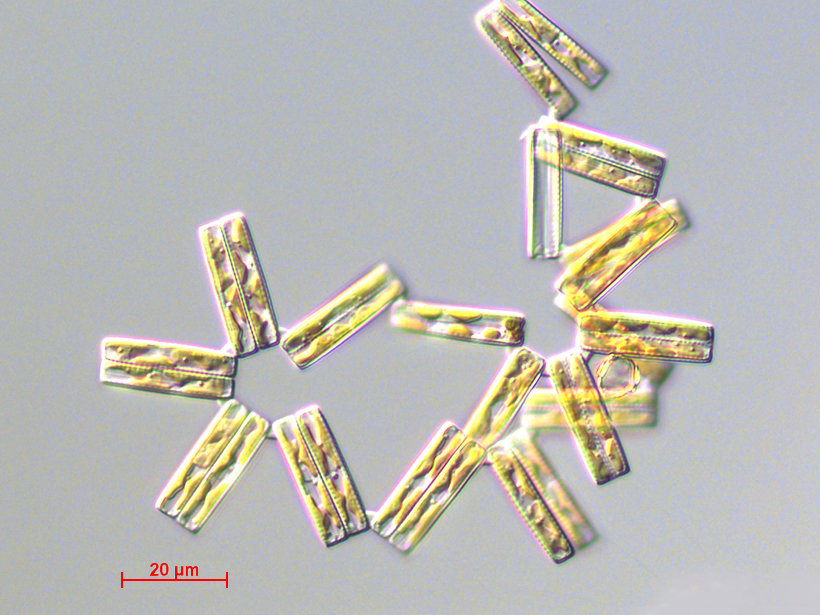Scientists studying past global temperatures and carbon dioxide (CO2) levels have struggled to explain a global cooling that occurred between 11 and 6 million years ago. Generally, such drops correspond with plummeting CO2, but previous measurements have found only a modest decrease in the greenhouse gas during the period. New research, however, has revealed a CO2 plunge that scientists have never before detected, and the clue lies in tiny ocean plankton.
Heather Stoll, a geologist from the University of Oviedo, Spain, led the research team and presented the findings—to be published in Nature Communications—at the 2015 American Geophysical Union Fall Meeting on Tuesday.

The study focused on diatoms and coccolithophorids—two types of tiny organisms that filled the oceans millions of years ago, just as they do today. Ranging in shape and color, these diverse plankton use photosynthesis for food and therefore require CO2. In particular, these plankton prefer CO2 containing the most common form of carbon called carbon-12, which they incorporate into calcified shells surrounding their microscopic bodies.
A Carbon Buffet
Stoll says that researchers have previously assumed that plankton starve without their favorite form of carbon. In fact, she said, desperate plankton abandon their fussy ways and adjust to other carbon forms.
“You can go to a buffet, and…if there’s a lot of food, you can get just what you want. You might get a chocolate éclair,” Stoll said. But if the buffet’s selection is depleted, “there might just be an apple and an orange.”
Like humans, plankton take what they can get. In low CO2 conditions, plankton have less access to carbon-12 and instead incorporate carbon-13. This means that the ratio of carbon-12 to carbon-13 in plankton shells offers clues to the amount of CO2 available in the atmosphere.
In a lab, using known CO2, Stoll’s team cultured plankton, examined the carbon ratio in the creatures’ shells, and hatched an equation correlating the carbon-12 to carbon-13 ratios to concentrations of atmospheric carbon dioxide. With that equation in hand, the scientists then pivoted from the lab to the field. They applied the equation to well-preserved fossils of ancient plankton shells from ocean sediment—specifically to plankton from the mysterious period between 11 and 6 million years ago.
Solving a Mystery
The team found that atmospheric CO2 levels were twice as high 11 million years ago as previously believed—roughly 1000 parts per million in volume instead of 550. These CO2 levels plunged to under 400 parts per million during the next 5 million years, according to the plankton shells. This fall would help explain the observed chill that overcame the planet during the same time period—a drop of several degrees Celsius.
“If they’re right, it will answer a lot of questions we’ve had for a long time.”
“I won’t guarantee you that 1000 [parts per million] is the right answer,” said Stoll, noting that the team needs more data to pin down the value with more certainty. But she says it’s clear that examining plankton’s shells in this fashion has “a big effect” on the data. Moreover, the results were consistent in both diatoms and coccolithophorids, even though the two types of plankton incorporate carbon into their bodies differently.
“If they’re right, it will answer a lot of questions we’ve had for a long time,” said Laura Peterson, a professor of environmental studies at Luther College, who was not involved in the research.
Although scientists have assumed that CO2 levels must have tracked with the ancient temperature drop, they’ve struggled to prove so until now. “These are the first results that have shown that,” Peterson said.
—Natalie Jacewicz, Science Writing Program Graduate Student, University of California, Santa Cruz; email: [email protected]
Citation: Jacewicz, N. (2015), Plankton reveal new secrets about ancient CO2 levels, Eos, 96, doi:10.1029/2015EO041835. Published on 16 December 2015.
Text © 2015. The authors. CC BY-NC 3.0
Except where otherwise noted, images are subject to copyright. Any reuse without express permission from the copyright owner is prohibited.

